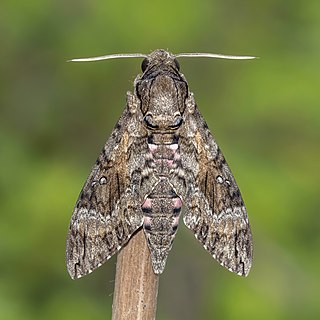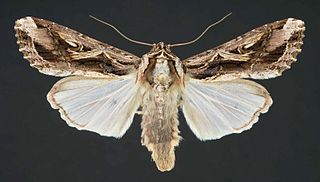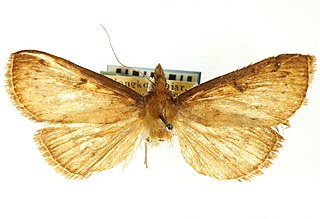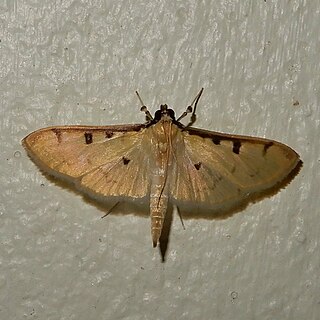
The sweet potato is a dicotyledonous plant that belongs to the bindweed or morning glory family, Convolvulaceae. Its large, starchy, sweet-tasting tuberous roots are used as a root vegetable. The young shoots and leaves are sometimes eaten as greens. Cultivars of the sweet potato have been bred to bear tubers with flesh and skin of various colors. Sweet potato is only distantly related to the common potato, both being in the order Solanales. Although darker sweet potatoes are often referred to as "yams" in parts of North America, the species is even more distant from the true yams, which are monocots in the order Dioscoreales.

Crambidae comprises the grass moth family of lepidopterans. They are variable in appearance, with the nominal subfamily Crambinae taking up closely folded postures on grass stems where they are inconspicuous, while other subfamilies include brightly coloured and patterned insects that rest in wing-spread attitudes.

Agrius cingulata, the pink-spotted hawkmoth or sweetpotato hornworm, is a moth in the family Sphingidae. The species was first described by Johan Christian Fabricius in 1775.

Pamiria omphisa, the dusky green underwing, is a species of blue (Lycaenidae) butterfly found in Asia.
Sweet potato latent virus (SPLV), formerly designated as sweet potato virus N, was first reported from Taiwan. The virus has flexuous, filamentous particles of approximately 700-750 nm long and induces typical cylindrical inclusion proteins in the cytoplasm of infected cells. The experimental host range of SPLV is wider than that of sweet potato feathery virus (SPFMV), and it induces symptoms on some Chenopodium and Nicotiana species. SPLV is serologically related to, but distinct from SPFMV. Sequence comparison of the 3’-partial sequences showed that SPLV was a distinct species of the genus Potyvirus in the family Potyviridae. The virus is common in China and has also been found in Korea and Rwanda.
Rhizopus soft rot is a disease of the sweet potato. It is one of the most common to affect the sweet potato, happening during packing and shipping. The disease causes a watery soft rot of the internal portion of the storage root. Strategies to manage the disease include the development of resistant varieties, curing through the use of heat and humidity, and application of decay control products.
Omphisa is a genus of moths of the family Crambidae described by Frederic Moore in 1886.

Physomerus grossipes, the sweetpotato bug or large spine-footed bug, is a species of Hemiptera in the family Coreidae. Native to Southeast Asia, the species has immigrated to the Pacific Islands. Frequently laying its eggs on the same Leguminosae and Convolvulaceae plants on which it feeds, the females of P. grossipes are very protective of their young, notably guarding both eggs and nymphs from predators.
Udea despecta, the Hawaiian sweetpotato leafroller, is a moth of the family Crambidae. It is endemic to the Hawaiian islands of Kauai, Oahu, Molokai, Maui, Lanai and Hawaii.

Spodoptera dolichos, the dolichos armyworm moth or sweetpotato armyworm moth, is a moth of the family Noctuidae. The species was first described by Johan Christian Fabricius in 1794. It is found from the southern United States, south through Costa Rica to South America, as far south as Argentina. In the United States, it may occur as far north as Kentucky and Maryland.

Omphisa fuscidentalis, the bamboo worm, is a moth of the family Crambidae. Its habitat are the bamboo groves and forests in the cooler regions of northern Thailand, northern Laos, northern Myanmar, and adjacent parts of Yunnan Province, China, it is also found in some parts of North east India. The mature caterpillars are viewed as a delicacy by the inhabitants of these regions.

Helcystogramma convolvuli, the sweet potato moth, sweetpotato webworm moth, sweetpotato leaf roller or black leaf folder, is a moth of the family Gelechiidae. It is mainly found in Asia and Africa, but there are also records from Oceania, the Middle East, the Caribbean and Florida in the United States. The species is also found on the Canary Islands and Madeira.

Lygropia tripunctata, commonly known as the sweetpotato leafroller, is a species of moth in the family Crambidae. It was first described by Johan Christian Fabricius in 1794. It is found in the United States, where it has been recorded from Texas to South Carolina and Florida. It is also found from the West Indies and Central America to Brazil.
Omphisa caustalis is a moth in the family Crambidae. It was described by George Hampson in 1913. It is found in the Democratic Republic of the Congo and Uganda.
Omphisa leucostolalis is a moth in the family Crambidae. It was described by George Hampson in 1918. It is found in Malawi.

Polygrammodes eleuata, the red-spotted sweetpotato moth or many-spotted moth, is a moth in the family Crambidae. It was described by Johan Christian Fabricius in 1777. It is found in Central and South America, on the Antilles and in the southern United States, where it has been recorded from Florida.
Acinetobacter larvae is a Gram-positive, aerobic, non-spore-forming, coccobacilli-shaped and non-motile bacterium from the genus of Acinetobacter which has been isolated from the gut of a larval from the insect Omphisa fuscidentalis.

Sweet potato cultivation in Polynesia as a crop began around 1000 AD in central Polynesia. The plant became a common food across the region, especially in Hawaii, Easter Island and New Zealand, where it became a staple food. By the 17th century in central Polynesia, traditional cultivars were being replaced with hardier and larger varieties from the Americas. Many traditional cultivars are still grown across Polynesia, but they are rare and are not widely commercially grown.











